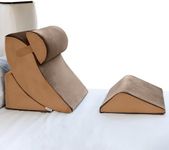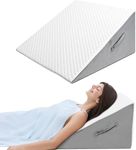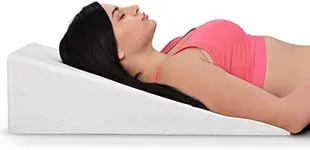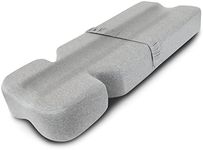Buying Guide for the Best Wedge Pillows
Choosing the right wedge pillow can make a big difference in your comfort, whether you need it for sleeping, reading, or medical reasons. Wedge pillows are designed to elevate part of your body, and the best one for you depends on your specific needs, such as relieving acid reflux, improving breathing, or supporting your back. To find the best fit, it's important to understand the key features and how they relate to your intended use.Angle of InclineThe angle of incline refers to how steeply the pillow elevates your body. This is important because a higher angle provides more elevation, which can be helpful for issues like acid reflux or snoring, while a gentler angle is better for general comfort or back support. Angles typically range from about 7 to 30 degrees. Lower angles (7-12 degrees) are good for mild elevation, such as easing lower back pain or providing gentle support. Medium angles (12-20 degrees) are often used for reading or watching TV in bed. Higher angles (20-30 degrees) are best for medical needs like acid reflux or respiratory problems. To pick the right angle, think about why you need the pillow: for medical elevation, go higher; for comfort or relaxation, a lower angle may be enough.
Size and DimensionsThe size and dimensions of a wedge pillow determine how much of your body it supports and how it fits on your bed. Some wedge pillows are narrow and only support your head and neck, while others are wide enough to support your entire torso or legs. If you move around a lot or want to use the pillow for your back or legs, a larger pillow may be better. If you just need head or neck support, a smaller pillow will do. Consider your bed size and how much space you want the pillow to take up when making your choice.
Material and FirmnessWedge pillows are usually made from foam, with varying levels of firmness. The material and firmness affect how supportive and comfortable the pillow feels. Memory foam offers contouring support and is good for people who want the pillow to mold to their body, while firmer foams provide more solid support and keep their shape better over time. If you need strong support for medical reasons, a firmer pillow is often best. For general comfort or if you prefer a softer feel, memory foam or a softer wedge may be preferable. Think about your comfort preferences and any medical advice you have received when deciding on firmness.
Cover Material and WashabilityThe cover material affects how the pillow feels against your skin and how easy it is to keep clean. Some covers are made from soft, breathable fabrics like cotton or bamboo, which are comfortable and help keep you cool. Others may be made from synthetic materials that are more durable but less breathable. Washability is important if you plan to use the pillow regularly, as removable and machine-washable covers make cleaning much easier. If you have allergies or plan to use the pillow every night, look for a cover that is easy to remove and wash.
Intended UseWedge pillows can be used for a variety of purposes, such as elevating the upper body, supporting the legs, or providing a backrest for sitting up in bed. Some are designed specifically for certain uses, like leg elevation or back support. When choosing a wedge pillow, think about how you plan to use it most often. If you need it for sleeping, make sure it's comfortable for long periods. If you want it for reading or watching TV, look for one that supports your back and neck in a sitting position. Matching the pillow to your main use will help you get the most benefit.



















